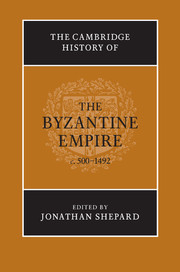Book contents
- Frontmatter
- General Introduction
- Part I The Earlier Empire c. 500–c. 700
- Part II The Middle Empire c. 700–1204
- 5 State of Emergency (700–850)
- 6 After Iconoclasm (850–886)
- 7 Religious Missions
- 8 Armenian Neighbours (600–1045)
- 9 Confronting Islam: Emperors Versus Caliphs (641–c. 850)
- 10 Western Approaches (700–900)
- 11 Byzantine Italy (680–876)
- 12 The Middle Byzantine Economy (600–1204)
- 13 Equilibrium to Expansion (886–1025)
- 14 Western Approaches (900–1025)
- 15 Byzantium and Southern Italy (876–1000)
- 16 Belle Époque or Crisis? (1025–1118)
- 17 The Empire of the Komnenoi (1118–1204)
- 18 Balkan Borderlands (1018–1204)
- 19 Raiders and Neighbours: The Turks (1040–1304)
- Part III The Byzantine Lands in the Later Middle Ages 1204–1492
- Glossary (Including some Proper Names)
- Genealogical Tables and Lists of Rulers
- List of alternative place names
- Bibliography
- Picture Acknowledgements
- Index
- References
14 - Western Approaches (900–1025)
from Part II - The Middle Empire c. 700–1204
Published online by Cambridge University Press: 28 March 2010
- Frontmatter
- General Introduction
- Part I The Earlier Empire c. 500–c. 700
- Part II The Middle Empire c. 700–1204
- 5 State of Emergency (700–850)
- 6 After Iconoclasm (850–886)
- 7 Religious Missions
- 8 Armenian Neighbours (600–1045)
- 9 Confronting Islam: Emperors Versus Caliphs (641–c. 850)
- 10 Western Approaches (700–900)
- 11 Byzantine Italy (680–876)
- 12 The Middle Byzantine Economy (600–1204)
- 13 Equilibrium to Expansion (886–1025)
- 14 Western Approaches (900–1025)
- 15 Byzantium and Southern Italy (876–1000)
- 16 Belle Époque or Crisis? (1025–1118)
- 17 The Empire of the Komnenoi (1118–1204)
- 18 Balkan Borderlands (1018–1204)
- 19 Raiders and Neighbours: The Turks (1040–1304)
- Part III The Byzantine Lands in the Later Middle Ages 1204–1492
- Glossary (Including some Proper Names)
- Genealogical Tables and Lists of Rulers
- List of alternative place names
- Bibliography
- Picture Acknowledgements
- Index
- References
Summary
byzantine links with the western christians, 900–950
Byzantium’s relations with the Latinwest in this period have a ‘Cheshire cat’ character in comparison with ninth-century exchanges. Very little attention is paid to the Christian west by Byzantine writers even when Saxon potentates begin to intervene in Italy and bedeck themselves with imperial trimmings. A memorandum of diplomatic procedures, compiled partly from older materials in the mid-tenth century, lists the standard form of address for letters to various reges, of ‘Gaul’ as well as Bavaria and Saxony: each is to be addressed as ‘spiritual brother’, unlike the numerous other addressees. But the protocols for receptions of ambassadors make no special provision for western ones: formulaic greetings for envoys from the Bulgarians and eastern Muslims are rehearsed, presumably because their visits were more important or frequent.
A somewhat later compilation would probably have paid western ambassadors little more attention than the Book of ceremonies did on the eve of the imperial coronation of Otto I (962–73). For Basil II (976–1025), as for his predecessors, the existence of a rival Bulgarian basileus mattered more. But if events beyond the Adriatic were generally of secondary importance to Byzantium’s rulers, the very powers which troubled them in the Balkans or hindered communications with the west obliged the empire to maintain far-flung bases from which to disrupt their activities. Byzantine claims in Italy were based on quite recent military actions and not merely on the inheritance of the old Roman empire.
- Type
- Chapter
- Information
- The Cambridge History of the Byzantine Empire c.500–1492 , pp. 537 - 559Publisher: Cambridge University PressPrint publication year: 2009
References
- 3
- Cited by

